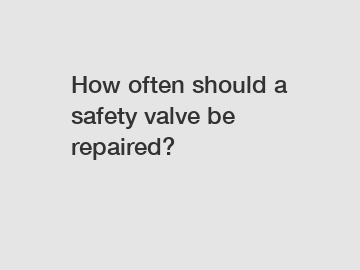Jan. 14, 2024
Mechanical Parts & Fabrication Services
You will get efficient and thoughtful service from HY.
In industries where maintaining high safety standards is absolutely crucial, safety valves play a pivotal role. These valves act as a last line of defense, protecting equipment and personnel from potential disasters. However, like all mechanical devices, safety valves require routine maintenance to ensure their continued reliability and effectiveness. In this blog post, we will delve into the critical question: How often should a safety valve be repaired?
Understanding Safety Valves.

Before we discuss the frequency of safety valve maintenance, let's familiarize ourselves with the purpose and function of these essential devices. Safety valves are pressure relief devices designed to release excess pressure from pressurized systems, preventing catastrophic failures. They are used in a wide range of industries, from oil refineries and chemical plants to water treatment facilities and power generation plants.
Importance of Regular Maintenance.
Regular maintenance of safety valves is of paramount importance to maintain their reliability and prevent potential hazards. Over time, these valves can experience wear and tear, which may compromise their functionality. Dust, debris, and corrosion can accumulate, obstructing the valve's movement and reducing its effectiveness. Additionally, safety valve parts can deteriorate, leading to leaks, improper sealing, or even complete failure.
Frequency of Safety Valve Repair.
The interval between safety valve repairs or overhauls depends on several factors, including the valve's operating conditions, industry standards, regulatory requirements, and the manufacturer's recommendations. It is crucial to consult the manufacturer's guidelines and adhere to the applicable regulations. However, as a general guideline, safety valves should undergo regular maintenance at least once every 12 to 24 months.
Factors Affecting Repair Frequency.
1. Operational Environment: Harsh operating conditions, such as high temperatures, corrosive substances, or abrasive materials, may require more frequent safety valve repairs.
2. Usage Intensity: Valves subjected to high-cycle operations or continuous heavy use may need more frequent maintenance intervals to avoid premature failure.
3. Process Variations: If a system experiences frequent pressure fluctuations or intermittent overpressure events, it may necessitate more frequent safety valve inspections and repairs.
4. Manufacturer Recommendations: Manufacturers often provide specific maintenance schedules based on their valve designs. Following their guidelines is crucial to ensure optimal performance.
Regular Visual Inspections.
While routine maintenance is crucial, visual inspections should also be conducted periodically. Trained personnel should visually evaluate safety valves to detect any potential issues between scheduled maintenance intervals. Visual inspections can help identify signs of wear, corrosion, or accumulation of debris that might hinder proper valve functioning. These assessments should be carried out at least once every three months, depending on the valve's operating conditions.
Expert Assistance for Comprehensive Inspections.
To ensure the highest level of safety, comprehensive inspections of safety valves by trained professionals are essential. These inspections aim to assess the valve's internal components and overall condition. The frequency of comprehensive inspections generally ranges from three to five years, based on operational intensity and industry-specific requirements. Experts can evaluate critical components, such as springs, discs, seals, and seats, to ensure their integrity and proper functioning.
Conclusion.
Maintaining and repairing safety valves is an integral part of ensuring a safe working environment. Regular maintenance, visual inspections, and comprehensive evaluations are all vital elements to extend the lifespan and reliability of these important pressure relief devices. By adhering to manufacturer recommendations, applicable regulations, and industry standards, businesses can minimize the risk of valve failure and potential disasters.
Remember, safety should never be compromised. When it comes to safety valves, it is always better to be proactive and address potential issues promptly than to face dire consequences later. Regular maintenance and inspections go hand in hand in preserving the effectiveness of these crucial devices, offering peace of mind and safeguarding both personnel and equipment.
Please visit our website for more information on this topic.
Are you interested in learning more about China marine cast bronze valves manufacturer? Contact us today to secure an expert consultation!
If you are interested in sending in a Guest Blogger Submission,welcome to write for us!
All Comments ( 0 )